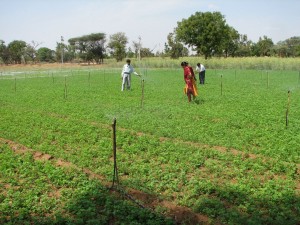 This is the first of three guest posts written by staff at the International Water Management Institute (IWMI). IWMI is a non-profit organization supported by the Consultative Group on International Agricultural Research (CGIAR) that targets water and land management challenges faced by poor communities in the developing world to reduce poverty and hunger and maintain a sustainable environment. (cross posted from Nourishing the Planet).
This is the first of three guest posts written by staff at the International Water Management Institute (IWMI). IWMI is a non-profit organization supported by the Consultative Group on International Agricultural Research (CGIAR) that targets water and land management challenges faced by poor communities in the developing world to reduce poverty and hunger and maintain a sustainable environment. (cross posted from Nourishing the Planet).
Ten years ago, the Chief Minister of Gujarat, India faced a shrinking state economy and a host of seemingly intractable problems. High on that list was a nearly bankrupt electricity board and powerful agricultural lobbies vehemently opposed to any reduction in subsidies on electricity that farmers were demanding to pump irrigation water, most of it from declining aquifers.
Based on recommendations made by international donors, power sector professionals, and researchers from the International Water Management Institute (IWMI), state politicians took a huge political gamble by investing US$260 million to revamp the statewide system for delivering electricity. This involved separating electricity feeder lines for agricultural and non-agricultural users. Within a few short years, they had propelled the state of Gujarat into the front ranks of agricultural production in India and resulted in a good many unexpected benefits for women, poor farmers, and the environment.
The success of the Jyotigram was not just expansion of rural electrification, but the way electricity was delivered. Before the scheme was implemented, main feeder lines served all the domestic, agricultural and commercial connections for a group of 2–5 villages. What Jyotigram did was separate the main feeder lines—one for agricultural use, one for domestic and commercial. Meters were installed on each feeder, especially the agri-feeders, to identify the source of any greater than expected demand on any particular feeder. This simple innovation had far reaching impacts.
By providing a continuous and reliable power supply, the Jyotirgram Yojana scheme made it possible for farmers to keep to their irrigation schedules, conserve water, save on pump maintenance costs and use labor more efficiently. These and other benefits helped drive agricultural production to new heights while improving the quality of life for farming families. While the GDP from agriculture grew at 2.9 percent per year for India as a whole, Gujarat recorded nearly 10 percent growth from 2000/01 to 2006/07—the highest in all India for that period.
In more human terms, providing continuous and reliable electricity to people in the state’s 18,000 villages had some far reaching impacts. Farmers were now able to keep to their irrigation schedules, conserve water, save on pump maintenance costs, and use labor more efficiently. Reducing some of the risk involved in farming helped boost on-farm incomes, which meant less out-migration to cities.
Some of the most profound impacts were improvements in the lives of rural women. Reliable electricity and higher household income meant that women had a bit more time to spend with their children in the evenings. The average duration of study time for boys and girls nearly doubled, and the school dropout rate for girls fell by 80 percent.
The environment benefited as well. Researchers from IWMI estimated that at the time there were over a million individual pumps drawing groundwater for irrigation. The high subsidies on electricity meant that farmers had no economic incentive to save water and tended to use far more than needed. The inevitable result was uncontrolled over-exploitation and rapidly declining aquifers. Since over 90 percent of groundwater withdrawal in Gujarat occurs through electrified pumps, electricity consumption can be used as a reasonably accurate proxy of groundwater withdrawal. Using government figures, IWMI calculated that electricity use for groundwater extraction fell by 37 percent between 2001 and 2006. If Gujarat can implement a state-wide program of managed aquifer recharge, the agricultural boom with all its attendant benefits to women and rural households just might be sustainable.
For more information on this and related projects, you can contact t.shah@cgiar.org or visit the IWMI websitewww.iwmi.org.

Danielle Nierenberg, an expert on livestock and sustainability, currently serves as Project Director of State of World 2011 for the Worldwatch Institute, a Washington, DC-based environmental think tank. Her knowledge of factory farming and its global spread and sustainable agriculture has been cited widely in the New York Times Magazine, the International Herald Tribune, the Washington Post, and
other publications.
Danielle worked for two years as a Peace Corps volunteer in the Dominican Republic. She is currently traveling across Africa looking at innovations that are working to alleviate hunger and poverty and blogging everyday at Worldwatch Institute’s Nourishing the Planet. She has a regular column with the Mail & Guardian, the Kansas City Star, and the Huffington Post and her writing was been featured in newspapers across Africa including the Cape Town Argus, the Zambia Daily Mail, Coast Week (Kenya), and other African publications. She holds an M.S. in agriculture, food, and environment from Tufts University and a B.A. in environmental policy from Monmouth College.








